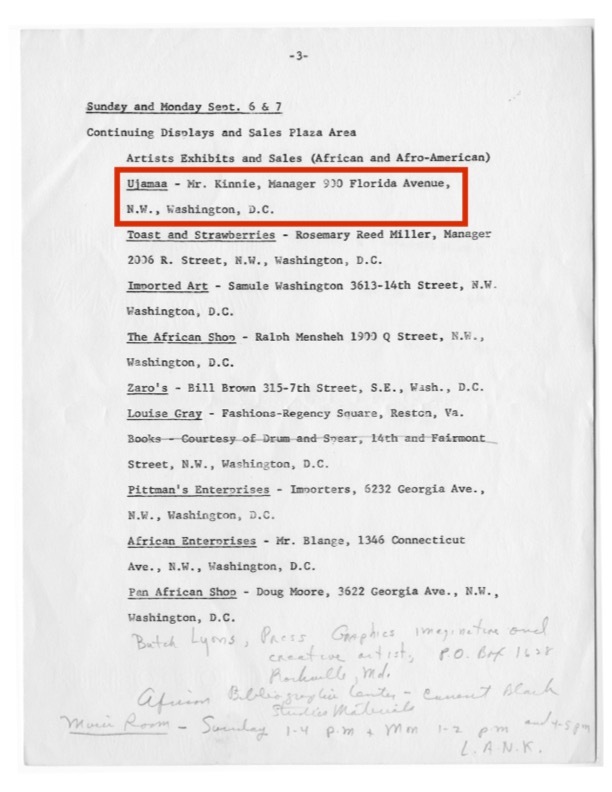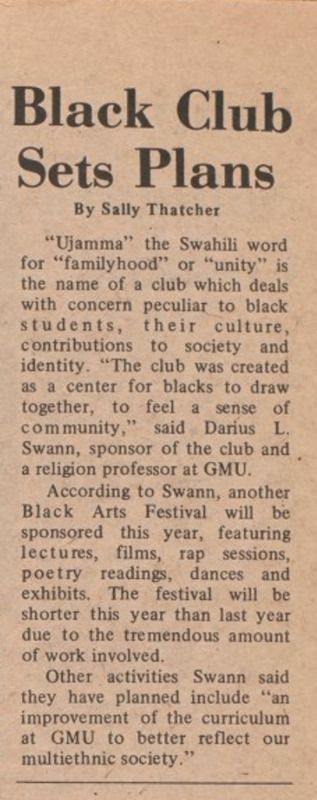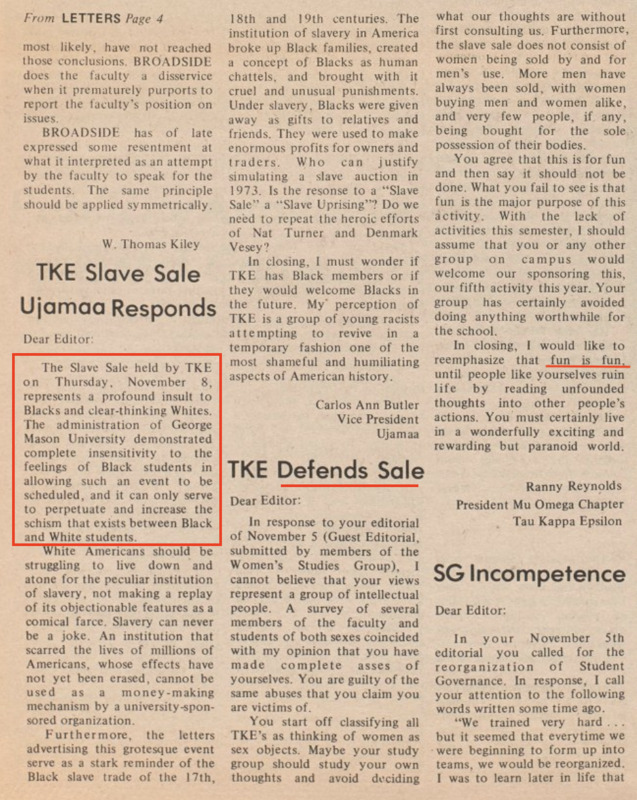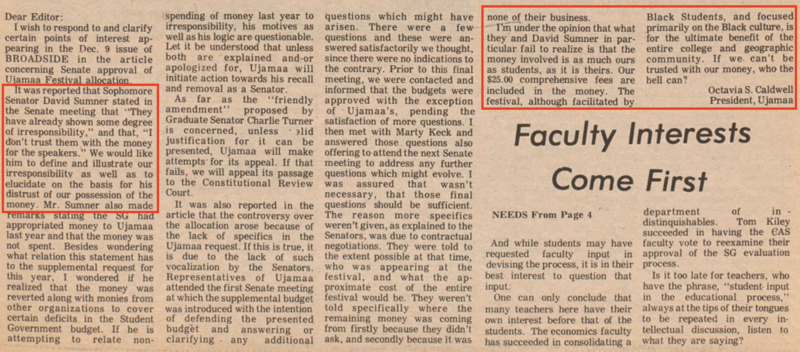Ujamaa - The Black Student Union
Ujamaa[1], established circa 1972, functioned as Mason’s Black Student Union and we first see evidence of the organization’s campus activity in The Broadside student newspaper, Spring 1973. Advised against organizing a Black Student Union, Ujamaa’s first act of fugitivity was establishing itself under another name. This covert act extends from others like it “at the center of black institutional life post-emancipation and is akin to the invisible institution, where black Americans engaged in independent religious worship, clandestine schools during slavery, and colored conventions during the antebellum period.”[2] Not in a black institution, Ujamaa relied on black faculty and local black community connections to build programming of cultural relevance on campus. Historically, black intellectual ideas often traveled through social channels so black teachers tapped into personal and professional networks to provide affirming educational content.[3] Leveraging those networks and connections, Ujamaa partnered with Reston Black Focus and modeled its first fugitive initiative after their 1971 Black Arts Festival [see images below].
Advised by Dr. Darius Swann, Ujamaa launched Mason’s first “Black Awareness Week,” April 1973, aligning themes with the Association for the Study of African American Life and History (ASAALH) – the non-profit established by Carter G. Woodson and responsible for present-day Black History Month[4]. Themed “African Art, Music, Literature; a Valuable Cultural Experience,” the week’s events included a Black Arts Festival, speakers on political and social issues, musical performances, and films by or about Black people [see video/image gallery below]. At this time SUB 1 was still under construction so events were held across Mason’s campus. Though not widely attended, Ujamaa considered “Black Awareness Week” a win for the entire student body and planned to make it an annual event. In The Broadside, Charles Smith from Ujamaa reflected on the event saying, “the most important achievement was its attempt to instill consciousness of a definite black subculture in this country. In all first attempts, there are bound to be blunders. For those who helped…we offer thanks…For those who questioned…we offer condolences.” The perseverance displayed Ujamaa is fundamental to fugitivity but also serves as an act of refusal. Endeavoring towards a liberatory education, Ujamaa’s members understood “liberatory progress required struggle, and struggle meant they couldn’t be afraid of failure.”[5]
Black History: Lost, Stolen or Strayed
By Fall 1973, Ujamaa’s Black Awareness Week was far in the rearview as Tau Kappa Epsilon (TKE), a white Greek organization, hosted a slave day auction[6] demonstrating how hostile campus culture was for black students. Not limiting their campus engagement to cultural events, Ujamaa addressed the absurdity of the event in the student newspaper [see image below]. TKE faced criticism from other campus organizations but doubled down on their decision to host the event with the chapter president stating, “fun is fun.” Which begs the question…Who was this fun for? Certainly not the black student body. It was apparent, by the event and its defense, that cultural awareness and sensitivity were nonexistent among the predominantly white students and faculty on campus.
As Spring semester 1974 began, Ujamaa continued its resistance of institutional oppression through a teacher evaluation initiative meant to equip current and future black students when choosing courses. Black students filled out evaluations on past teachers to provide insight into the teacher-student dynamic they experienced, positive or negative. This form of creative maladjustment, a phrase originally coined by Dr. Martin Luther King Jr. as a practice of continuous freedom fighting and expanded by Herbert Kohl, was an act of “not-learning.” According to Kohl, “Not-learning tends to take place when someone has to deal with unavoidable challenges to her or his personal and family loyalties, integrity and identity. In such situations there are forced choices and no apparent middle ground. To agree to learn from a stranger who does not respect your integrity causes a major loss of self. The only alternative is to not-learn and reject the stranger’s world.”[7] For black students, knowing which professors to avoid because of possible prejudice lessened their likelihood of failing. Furthermore, their fugitive act of refusal challenged the status quo and the reinforcement of deficit ideologies by faculty.
By Fall 1974, planning was in full swing for Ujamaa’s 1975 Black Arts Festival, led by new President Octavia Caldwell [see images below]. The black student body had roughly 100-members and those who were active with Ujamaa met in SUB 1 weekly to help with planning. Like the year prior, Ujamaa reached out to the local black community for support and as a slightly larger group also established avenues for giving back from festival proceeds. Local teacher and participant in the 1971 Reston Black Focus festival, Carlton A. Funn, exhibited at the 1975 festival. Mr. Funn’s exhibit was a 19-year collection titled “The History and Culture of Minorities” that promoted awareness, dignity, and cultural understanding. A seventh-grade history teacher in Alexandria, Mr. Funn started his of collection of books, pamphlets, newspaper articles, and other artifacts in the 1950s to supplement the dominant curriculum taught to his class of 30 black student. The exhibit eventually grew to over 1500 items, traveled the world, and was renamed the “National/International Cultural Exhibit.”[8] Carlton Funn, like Carter G. Woodson, was what Givens calls an abroad mentor, someone who provided “curricular alternatives that invited new pedagogical practices for teaching black students. For African American teachers, educating black students was more than developing ordinary academic skill sets. It was fundamentally about challenging and transcending antiblack sentiments that structured the world.”[9] Carlton Funn’s exhibit was integral to every Black Arts Festivals on campus and after the final festival in 1977, he continued to exhibit on Mason into the mid-1990s.
Carlton Funn - The Importance of Being NICE
When we think of the wealth of America; when we remember the number of foundations today which have sums that they do not know how to use, it is no credit to the nation that they helped Woodson so little. Many of them of course will declare that they were willing to help, but that Woodson was not exactly to be “trusted”; he would not come to heel when whistled to, and fawn. Their willingness to help was therefore always accompanied by a desire, unobtrusively, of course, to control or at least direct in general lines the work which Woodson was doing. This Woodson absolutely and definitively refused to allow. —W. E. B. Du Bois (1950)[10]
While planning the 1975 festival Ujamaa encountered funding obstacles with the student government. According to Octavia Caldwell’s letter to the Broadside [see image below], a student government senator alleged Ujamaa had been irresponsible with funds, and he didn’t trust them. The apparent basis for his distrust stemmed from unspent money allocated for the 1973 Black Arts Festival that reverted to the student government budget. Her letter continues revealing the student government’s heightened scrutiny of Ujamaa’s request for funds at the budget meeting where questions were asked about the specifics of their plans for the funding. Ujamaa representatives answered the questions and when no additional questions arose, assumed the answers were satisfactory. However, when the student government released the budget, Ujamaa’s funds were pending approval of satisfactorily answered additional questions. Understandably frustrated, Caldwell closed her letter highlighting Ujamaa’s right to funds paid into by their membership’s comprehensive fees and asked, “If we can’t be trusted with our money, who the hell can?”
Despite contestation, Ujamaa executed the 1975 Black Arts Festival and it was huge success for Mason and the local community. So much so, the university took over funding the following year [see images below], although there isn’t an explicit explanation for the takeover. The 1976 and 1977 Black Arts Festivals were advertised as university partnerships with Ujamaa and the Office of Minority Affairs, respectively, but seemingly ceased to occur after 1977. Also, the 1976 Black Arts Festival is the final mention of Ujamaa in the student newspaper, however in 1977 the Black Student Alliance emerged as a more politically focused organization and force to be reckoned with.
The voices of Carlos Ann Butler, Octavia Caldwell, Charles Smith, and other members of Ujamaa, are critical to understanding what was happening on campus, and yet black student voices rarely appear in formal school records. The distinct parallels of contestation experienced by Ujamaa members and Carter G. Woodson, one of which is illuminated in the above quote by W.E.B. Du Bois, are not uncommon. In fact, the barriers they faced are the norm – perpetual extensions of white supremacist surveillance endured by black people, and black educators specifically, for centuries. Whether it was “the fugitive slave; the literate slave; the slave “learning as a means of escape”; the teacher secretly reading from the textbook that documents these very origins of fugitive pedagogy…these were all black flight. [And] the relational dynamics between black learning, flight, and surveillance of black life prefigured the [black] educational agenda.”[11]
[1] Sira Anissa I Thiam, “Ujamaa,” Black Lives Next Door, 2022, https://research.centerformasonslegacies.com/s/blnd/page/ujamaa.
[2] Jarvis R. Givens, “The Association ... Is Standing Like the Watchman on the Wall,” essay, in Fugitive Pedagogy (Harvard University Press, 2021), 63, https://www.jstor.org/stable/j.ctv1h9dg3p.6.
[3] Jarvis R. Givens, “Fugitive Pedagogy as a Professional Standard: Woodson’s ‘Abroad Mentorship,’” essay, in Fugitive Pedagogy (Harvard University Press, 2021), 161, https://www.jstor.org/stable/j.ctv1h9dg3p.9.
[4] “Black History Month,” Wikipedia, https://en.wikipedia.org/wiki/Black_History_Month.
[5] Yanira Rodríguez, “Pedagogies of Refusal: What It Means to (UN)Teach a Student like Me,” Radical Teacher 115 (2019): 5–12, https://doi.org/10.5195/rt.2019.672.
[6] Jacob Connelly, “From Slave Day to Derby Days - 1960s into 1970s: George Mason and Racial Ridicule,” Black Lives Next Door, 2023, https://research.centerformasonslegacies.com/s/blnd/page/gmu-and-racial-ridicule-cont.
[7] Herbert Kohl, “On Not-Learning,” The Threepenny Review, 1992, https://www.jstor.org/stable/4384109.
[8] “Carlton Funn Collection,” City of Alexandria, VA, January 25, 2022, https://www.alexandriava.gov/museums/carlton-funn-collection.
[9] Jarvis R. Givens, “Fugitive Pedagogy as a Professional Standard: Woodson’s ‘Abroad Mentorship,’” 160-161.
[10] Jarvis R. Givens, “The Association ... Is Standing Like the Watchman on the Wall,” essay, in Fugitive Pedagogy (Harvard University Press, 2021), 62, https://www.jstor.org/stable/j.ctv1h9dg3p.6.
[11] Jarvis R. Givens, “Introduction: Blackness and the Art of Teaching,” essay, in Fugitive Pedagogy (Harvard University Press, 2021), 21, https://www.jstor.org/stable/j.ctv1h9dg3p.4.





















